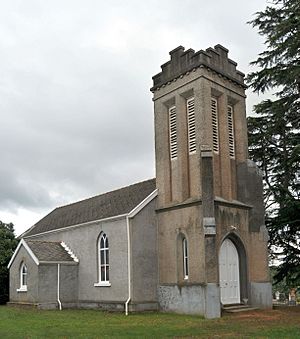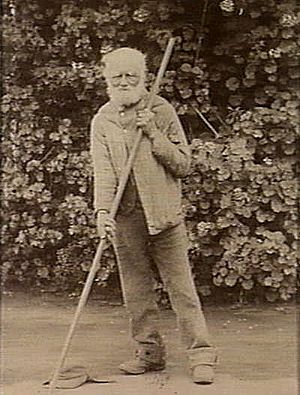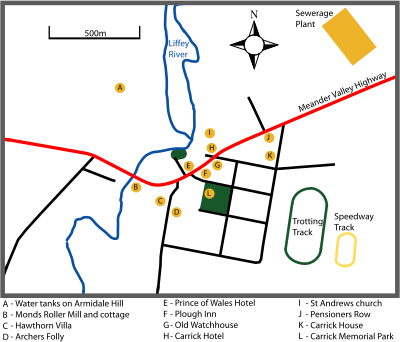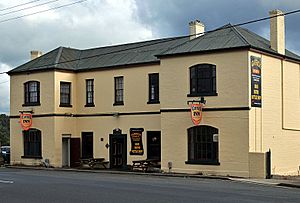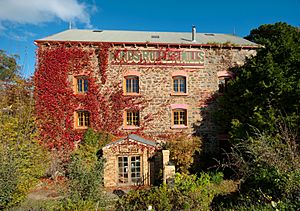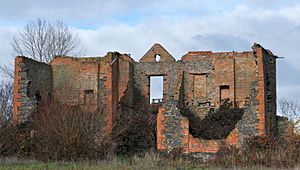Carrick, Tasmania facts for kids
Quick facts for kids CarrickTasmania |
|||||||||
|---|---|---|---|---|---|---|---|---|---|
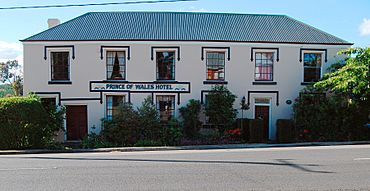
Carrick's former Prince of Wales Hotel
|
|||||||||
| Population | 432 (2016 census) | ||||||||
| Postcode(s) | 7291 | ||||||||
| Elevation | 79 m (259 ft) | ||||||||
| Location |
|
||||||||
| LGA(s) | Meander Valley Council | ||||||||
| State electorate(s) | Lyons | ||||||||
| Federal Division(s) | Lyons | ||||||||
|
|||||||||
Carrick is a small, old village about 17 kilometres (11 mi) west of Launceston, Tasmania, Australia. It sits right by the Liffey River. The Meander Valley Highway goes through the middle of town. This road used to be the main route connecting Launceston to other towns like Deloraine and Devonport.
Carrick is special because it has many well-preserved buildings from the 1800s. Fifteen of these old buildings are listed on the Tasmanian Heritage Register. Some famous ones include Carrick House (built in 1840), St Andrew's Church (1848), the Old Watch House (1837), Monds Roller Mill (1846), and the Carrick Hotel (1833).
The first land in Carrick was given out in 1818. About ten years later, William Bryan started building a wooden mill by the river. This mill helped the town grow, and land plots were sold in 1838. The Carrick Post Office opened in 1841. Carrick has always stayed small, with its population usually between 200 and 439 people. Today, many people who live in Carrick work in Launceston or the nearby farming areas.
The "Monds Roller Mill," a stone building from 1846, is a very important landmark in Carrick. This mill, and an earlier wooden one, were key to the town's success in the 1800s. It was the last flour mill in Tasmania to be powered by water, closing in 1924. Near the mill, you can see the ruins of Archer's Folly. This was meant to be a grand house, but it was never finished.
Carrick has a long history with horse racing, which started even before the racecourse was built in 1848. For a while, it hosted the oldest horse race in Australia. Today, the town is home to harness racing, speedway racing, and cycling events. Carrick also hosts Agfest, which is Tasmania's biggest event and one of Australia's largest agricultural shows.
| Top - 0-9 A B C D E F G H I J K L M N O P Q R S T U V W X Y Z |
Carrick's Story: A Look Back
Early Days
The land around Carrick was originally home to the Northern Midlands group of Tasmanian Aboriginal people. There are no known records of Aboriginal heritage sites in the immediate area.
The first land grant in Carrick was given in 1818 to Thomas Haydock Reibey. His son, Thomas Reibey, later became the Premier of Tasmania. This grant covered a large area, including where the town now stands. In the early 1820s, there were only a few settlers scattered around.
Captain William Thomas Lyttleton received land near Carrick in 1825. At first, the area was even called Lyttleton. The river, now known as the Liffey, was then called The Pennyroyal Creek.
William Bryan, who arrived from Ireland in 1824, bought land in Carrick in 1826. He started building a mill on the river, which was the main reason the town began to form. By 1828, a simple log bridge was built over the river. Bryan later used his influence to rename the town and the river "Carrick," after his homeland. The road from Launceston to Carrick opened in 1831. The government sold town lots in late 1838.
Life in the 1800s
Samuel Pratt Winter managed Bryan's mill from 1834 and later leased it. In 1841, a post office opened. By the end of that year, Carrick had four homes, a blacksmith shop, a police station, the flour mill, and a hotel made of mud and straw.
St Andrew's Church was built in 1843 by Thomas Reibey as a school. He also donated the land for the church. In 1846, the old wooden mill was replaced with the stone "Monds Roller Mill." Carrick grew a lot in the late 1850s, partly because people were returning from the Victorian gold fields. Many cottages in Carrick were built for workers on the Reibey family's Entally Estate near Hadspen.
By 1859, Carrick had two mills, a brewery, and four inns. A public library was started in 1860. Thomas Monds, an experienced miller, bought the stone mill in 1867. When a railway line was built nearby in 1869, less traffic came through Carrick, which affected local businesses.
A government school opened in the 1870s, with 65 students by 1901. Monds' business grew, bringing more wealth to the town. He built a large grain store and opened offices in Launceston. At its busiest in the 1800s, Carrick had about 400 people and four hotels. However, the town didn't have a proper water supply, relying on wells and rainwater.
Getting Around: Roads and Railways
The Liffey River was first bridged in Carrick in 1828 with a simple log structure. This was replaced with a stronger wooden bridge in the 1830s. Roads were often poor, and vehicles would get stuck. A bridge over the South Esk River in Hadspen was built in 1843, making it easier to travel between Carrick and Launceston.
The Liffey bridge was repaired and raised in the 1860s. However, in 1875, it collapsed due to water damage. All the Liffey bridges and roads in the area would flood, and the 1929 Tasmanian Floods even washed the bridge away. In the 1950s, the road and bridge were rebuilt and raised significantly to prevent flooding.
When the railway line was built nearby in 1869, fewer people traveled through Carrick by road, which hurt the town's businesses. Passenger train services stopped before 1978. Today, the main road through Carrick is called the Meander Valley Highway. The Bass Highway, a major road connecting Launceston to other cities, now passes south of the town.
Fun and Games: Sports in Carrick
Carrick has a long and exciting history with horse racing. The Reverend Thomas Reibey helped start a racing club and racecourse. Racing first began on a property called "The Moat." Reibey later gave land for a new racecourse, which was considered "the best in Tasmania" in 1859. The Carrick Plate race was held every year from 1849 to 1913, making it the oldest race in Australia!
After 1913, the track was used for trotting (a type of horse racing where horses pull a driver in a two-wheeled cart). The Carrick Trotting Club was formed in 1914. Today, the Carrick Park Pacing Club hosts several race meetings and trial sessions each year.
Next to the trotting track is a speedway. Construction of the speedway started in 1967, and the first races were held in 1968. It's been in use ever since, with crowds of over 10,000 people sometimes attending!
Carrick also often hosts cycling events, which have been recorded as far back as 1897. If you like fishing, the Liffey River is a great place to catch brown trout during the fishing season.
Water and Services
Getting clean water in Carrick used to be a challenge. In the 1880s, water was brought from the mill's water channel because well water was too salty. Thomas Monds later installed pumps to bring water from the river to tanks in town, which he sold to residents. However, the mill always had priority for river water, especially during droughts.
A proper water supply system was completed in 1890, pumping water from the river to tanks that supplied some houses and public troughs. But a typhoid outbreak in the early 1900s was blamed on this water, so the pumps were shut down. The town went back to relying on rainwater tanks, wells, and water brought from the river.
In 1961, local residents formed a group to build a reservoir on Armidale hill, supplied by the river. Volunteers did much of the work to save costs. This new system started supplying water in 1961.
For a long time, Carrick's growth was limited because it didn't have a town sewerage system. A sewerage plant was built in the mid-1970s, and by 2008, most of the town was connected to both treated water and sewerage. Today, Carrick's water comes from the Mount Leslie Water Treatment Plant, which treats water from the Trevallyn Dam.
Learning and Schools
Thomas Monds helped start the first private school in Carrick in 1843. However, Thomas Reibey turned this building into St Andrew's Church in 1845, and the school moved. A government school was built in 1873. Both schools were open in 1883.
The private school closed in the late 1800s. The government school, a wooden building, was renovated in 1920 but closed in the mid-1930s. The building was moved to nearby Hagley in 1938. Since then, there hasn't been a school in Carrick. The government started funding school transport for children from Carrick to the school in Hagley.
Nature and Wildlife
Since European settlers arrived, the land around Carrick has been divided up and used for farming. In 1855, a traveler noted that the area was heavily farmed.
You might find some interesting plants and animals here. The endangered growling grass frog has been seen in the area. Some undisturbed spots have native grasses like Poa labillardierei and Themeda triandra. The Glycine latrobeana (clover glycine) was recorded south of town in 1984. The Discaria pubescens (Hairy Anchor Plant), which is on the state's endangered list, was found northeast of town in 2001.
Besides the introduced brown trout, the Liffey River is home to platypus. Sadly, platypus in the river have sometimes been found with a dangerous fungal infection called Mucor amphiborum.
Faith and Churches
Carrick has one active church today, St Andrew's, which is an Anglican church. Church of England services (now known as the Anglican Church of Australia) first began around 1843 in a blacksmith's shop. Later, they moved to a schoolhouse, which was then turned into St Andrew's Church.
Thomas Reibey had the schoolhouse converted into a church by 1845. He donated the land and paid for the rectory (the minister's house) and the church organ. The church's cemetery was officially set aside in April 1845, and the church itself was blessed in November 1845 by Tasmania's first Church of England Bishop. Thomas Reibey was the first minister of St Andrew's.
A Wesleyan chapel was built in 1865, but it later became a private home and was torn down in the 1930s. There has never been a Roman Catholic church in Carrick; the closest one is in Westbury.
Where is Carrick?
The town of Carrick is about 17 kilometres (11 mi) from Launceston. It's located on the Meander Valley Highway (B54), between the towns of Hadspen and Hagley. The Liffey River flows through the western part of the town, coming from the Great Western Tiers mountains, past the Liffey Falls, and through Bracknell and Bishopbourne. Soon after passing Carrick, the Liffey River joins the Meander River.
People and Population
Carrick's population has always been small. In 1836, there were 430 residents, and for most of the 1800s, it stayed around 400. By 1976, the population had shrunk to about 200 people living in 70 buildings. However, the population grew again in the late 1900s, with 317 residents in 2001 and 439 in 2006.
Today, Carrick is mainly a place where people live if they work in Launceston or the surrounding farming areas. It's also a quiet place for retirement. Most residents in 2006 were born in Australia (87%) and spoke English at home (92.7%).
One interesting former resident was Sammy Cox (also known as Samuel Emanuel Jervis) (around 1773–1891). He claimed to have been born in Wales or England in 1773. He said he jumped off a ship near Tamar heads in 1789 and lived with local Aboriginal people for 26 years. If true, this would mean he lived in Tasmania before the first recorded European settlement in 1803! In 1814, he met the Cox family and took their surname. He worked as a gardener and lived in a cottage near Carrick for about 50 years. He died in 1891, claiming to be 117 years old. His story is well-known, and the dining room of the Carrick Hotel is named after him. However, some historians believe his story might be a tall tale.
Thomas Reibey is often called the Father of Carrick. He played a huge role in building the church, the racecourse, and other historic buildings in town. He donated a lot of money for the Anglican church and became an important church leader. Reibey was also elected to the Tasmanian Parliament in 1874 and served for 30 years, even becoming the Premier of Tasmania from 1876 to 1877. He loved horse racing, and his horse "Stockwell" won important races.
Thomas Wilkes Monds was a successful miller who bought the stone mill in Carrick in 1867. His successful management of the mills brought wealth to him and helped the town prosper. He built a large house called "Hawthorn" in 1875 and owned other properties in Carrick. Monds was also involved in local government for many years.
Carrick Today
Carrick is still a small, historic village. It's mostly a place where people live if they work in Launceston or the nearby farming areas. The town hasn't changed much from its 1800s look. The local council wants to keep Carrick small and prevent it from merging with Hadspen. New buildings are only planned within the town's current boundaries.
There aren't many businesses in Carrick because the population is small. However, you can find a roadhouse, a post office, a hotel, a copper and metal gallery, and some places to stay. The old Monds milling operation, now owned by Monds and Affleck, is still active just south of the Bass Highway. It's said to be "Tasmania's only large-scale commercial feed milling operation."
Carrick hosts several events, including the famous Agfest field days, trotting races, speedway racing, and cycling events. Next to the ruins of Archer's Folly, you can visit the Tasmanian Copper and Metal Art Gallery, where the Marik family creates and sells beautiful copper artworks. Because the town hasn't changed much, it has many colonial buildings and old trees, giving it a special charm. The 1846 stone "Monds Roller Mill" is still the most famous building.
Agfest: A Big Event
Agfest is a huge annual agricultural show held every May in Carrick. It's the biggest event in Tasmania and one of the largest agricultural field days in Australia. Agfest is run by the Rural Youth Organisation of Tasmania, and the money raised helps support rural communities.
It first started in 1982 near Perth, Tasmania. But the organizers soon needed a bigger space. In 1986, they bought land on Oaks Road in Carrick. This land was originally part of the "Oaks Estate" owned by Thomas Haydock Reibey. They named the new site "Quercus Rural Youth Park" (Quercus is the Latin name for oak). The first Agfest at this new location was held in May 1987. Agfest has grown a lot, attracting up to 70,000 visitors over three days each May!
Historic Buildings of Carrick
Carrick has many well-preserved buildings from the 1800s. Fifteen of these properties are listed on the Tasmanian Heritage Register, meaning they are important to Tasmania's history. Some are also listed on the Register of the National Estate.
- Pensioner's Row: These are two joined brick cottages built by Thomas Reibey. They were originally for the blacksmith and saddler who worked for the "Entally Estate."
- Ivy Cottage: A heritage-listed cottage nearby, once called "Ivy Cottage" because of the ivy growing on it. It used to be a private school.
- Old Police Watch-house: Built in 1837 using convict labor, it's located across from the Carrick Inn.
- Prince of Wales Hotel: Built in 1840, this building was a hotel for many years but is now a private home.
- Sillwood: The remains of an old farm building from a large land grant in 1835.
- Carrick House: Built around 1840, this two-story brick house was once linked to horse racing, with its stables used for training.
- Mill Cottage: Behind the stone mill, this single-story brick cottage was built around 1840. Thomas Monds later expanded it.
- The Carrick Hotel: This two-story brick building from 1833 is the only licensed hotel in Carrick and has always been a hotel.
- The Plough Inn: Built in 1841, this two-story brick building was also known as the Carrick Inn. It stopped operating as an inn by 1863 and has since been a bakery, art gallery, and private home.
Monds Roller Mills: A Key to Carrick's Past
The Monds Roller Mills building is a four-level, three-story stone building with a gabled roof, built around 1846. This mill was the main employer in Carrick for many years and was the last water-powered mill in Tasmania.
The first mill was made of wood and powered by a water wheel. Samuel Pratt Winter managed it from 1834. In 1846, he arranged for the old wooden mill to be removed, and the current stone building was started. This new mill used a water wheel to power its grinding stones.
Thomas Wilkes Monds, an experienced miller, bought the mill in 1867. He and his family moved into the small cottage behind the mill. Over time, Monds updated the mill's machinery. In 1887, the water wheel was replaced with a powerful "Victor" turbine. In 1889, the mill switched from traditional millstones to roller milling, which produced whiter flour that people wanted.
Monds' oldest son took over managing the mill in 1882, and Monds himself moved to Launceston in 1888. The mill was one of the first places in town to get telephones in 1893.
The mill stayed in the Monds family until 1918, when their company merged with another. The new company, Monds & Affleck, only operated the mill until 1924 and never reopened it. By 1931, it had been closed for years. The mill was sold in 1947 and fell into disrepair. In 1984, it was renovated and opened as a restaurant, then a wedding venue. It closed again but was being renovated in 2008 with plans to reopen.
St. Andrew's Church: A Place of Worship
St. Andrew's Church is an active Anglican Church. The building is made of brick with a tall, square tower. It sits on 14 acres (6 ha) of land, which includes a cemetery and a rectory, right next to the Liffey River.
The building was started in 1843 by Thomas Reibey as a school. He had it turned into a church in 1845. Reibey donated the land for the church and paid for the rectory and the church's organ. The cemetery was officially set aside in April 1845, and the church itself was blessed in November of the same year. The tower was added later, in 1863. The church was renovated around 1900, with a new roof and beautiful stained glass windows.
The church has a bell in its tower, made in England from iron and steel and lined with silver. The church also has an organ that was originally in the crypt of St Paul's Cathedral, London. It was built around 1839 and is still used today after a full restoration in 1987.
Archer's Folly: An Unfinished Dream
John Kinder Archer began building a huge mansion on Bishopbourne Road in 1847. It was designed to be a grand, two-story house with large rooms and a domed driveway through the middle. However, when only four rooms were finished, a ship carrying many of the building supplies sank. Because there was no insurance, Archer stopped building.
Thomas Monds bought the unfinished building in 1867 and used it to store grain. Archer's unfinished work became known as Archer's Folly. People in 1883 described it as both unfinished and ugly. By 1946, it was still incomplete and used as a barn. In 1978, a fire broke out, leaving only a roofless shell. Today, the Marik Metal Art studio and workshop are built next to this grand ruin.
Hawthorne Villa: A Historic Home
Hawthorne Villa is a beautiful two-story red-brick building in the Gothic-revival style, built by Thomas Monds in 1875. It's surrounded by English-style gardens with two huge Californian Redwoods. The Villa was built on the site of Carrick's first hotel, an old mud-and-straw inn from the 1830s. Some bricks from the old building were even used in the new villa. Today, "The Stables," located in the Villa's gardens, offers accommodation for visitors.
Images for kids





